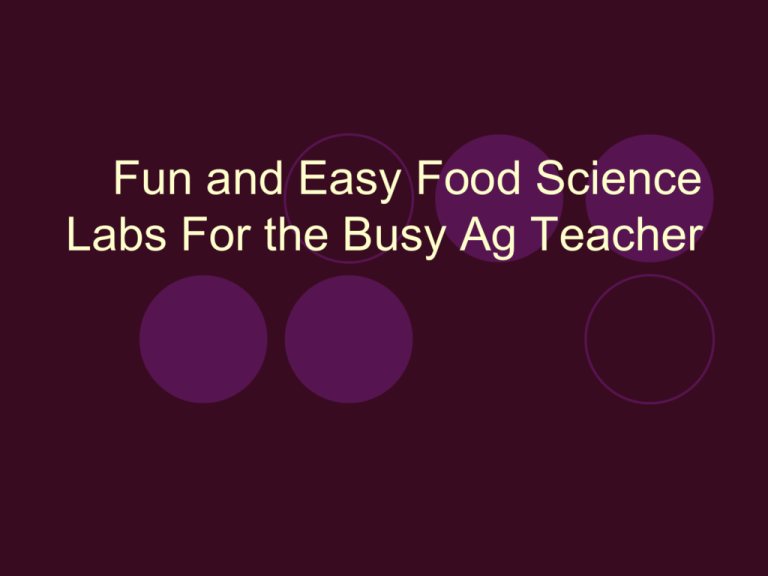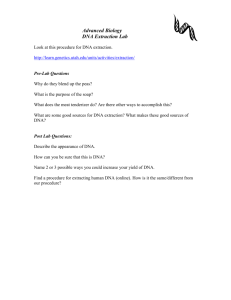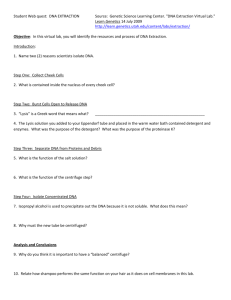Fun and Easy Food Science Labs For the Busy Ag Teacher
advertisement

Fun and Easy Food Science Labs For the Busy Ag Teacher Why Food Science? Expanding value added products industry Ties into multiple subject area standards Ties concepts into things students relate to Adds excitement to your lessons Labs can be easily adapted to basic or complex curriculum DNA Extraction Lab - Materials Material with DNA Detergent (ie. Dish soap) Enzymes (Meat Tenderizer, Pineapple Juice or Contact Lens Solution) Isopropyl Alcohol (70 or 95%) Cold Water DNA Extraction Lab - Materials Ziploc Bags Test tubes Wooden Sticks Pipettes or eyedroppers Measuring cups/spoons Coffee filters and cups Salt DNA Extraction - Procedure Step 1 – Measure out a ¼ cup of your chosen material Step 2 – Place material in ziploc bag and completely crush Step 3 – Add up to a ½ cup cold water DNA Extraction - Procedure Step 4 – Mix thoroughly Step 5 – Strain through coffee filter into a cup Step 6 – Add about 2 T of detergent and a pinch of salt (swirl gently)– let sit for a minimum of 10 min Gum Drop Lab - Materials Jello Sugar Water Pipettes or eyedroppers Plates Spoons Gum Drop Lab - Procedure Step 1 – Measure out a portion of Jello powder on your spoon – Place on plate Step 2 – Using pipetter add a few drops of water while mixing it into your jello Step 3 – Add more water or Jello mix as needed Gum Drop Lab - Procedure Step 4 - Form gum drop into desired shape Step 5 – Roll in sugar Step 6 – Enjoy! DNA Extraction Procedure Step 7 – Add a pinch of meat tenderizer into test tube Step 8 - Fill test tube 1/3 full of DNA/Detergent solution – (mix gently) Step 9 – Hold test tube at a 45° angle DNA Extraction Procedure Step 10 – Slowly fill test tube with an equal amount of alcohol Step 11 – After the DNA has begun clumping harvest it with your wooden stick DNA can be preserved in an alcohol solution for long term storage Sensory Lab #1 - Procedure Step 1 – Obtain a small sample of each Kool Aid in a small cup for sampling Step 2 – With your lab partner taste your first sample and try to determine what flavor it is. Record your observations and flavor guess Sensory Lab #1 - Procedure Step 3 – Cleanse your tasting palette with water Repeat steps 2 and 3 for each sample of Kool Aid Plastic From Corn Lab - Materials Corn Starch Water Cups Spoons Optional – corn oil and microwave Plastic From Corn Lab - Procedure Step 1 - Add a spoonful of cornstarch to your cup Step 2 – Add an equal amount of water to your cornstarch and mix Plastic should be the consistency of thick glue Step 3 – Add more water or cornstarch as needed Plastic From Corn - Procedure Step 4 – Check the surface tension of the mixture Step 5 – Pour mixture into your hand and try to form it into a ball – Once formed observe how it reacts to the heat of your hand Step 6 – Have fun with your plastic carefully observing how it moves between a liquid and a solid Sensory Lab # 2 - Materials Glass or Plastic Vials Various samples of food extracts and spices taken from the Food Science and Technology CDE list Sensory Lab #2 - Procedure Step 1 – Obtain a sensory sample set for your group Step 2 – Take sample #1 and record its color, texture and what you think the sample is made of Step 3 – Continue until all samples are observed Possibilities Cinnamon Maple Lemon Vanilla Cherry Butter Garlic Nutmeg Lilac Licorice (anise) Molasses Strawberry Oregano Lime Almond Menthol Peppermint Ginger Banana Basil Orange Onion Clove Pine





